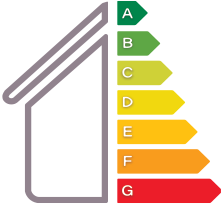Certified by the following organisations

In 2014 the government reported that almost 40% of the UK’s energy consumption and carbon emissions come from the way buildings are heated, lit and used.
In 2019 the UK became the first major economy in the world to pass laws to end it’s contribution to global warming by 2050. The UK government set a target to achieve net zero greenhouse gas emissions by 2050, which superseded their previous target of reducing greenhouse gas emissions by at least 80% in comparison to levels in 1990.
This is an ambitious target and as such the government is regularly updating existing or bringing out new regulations and standards that industries and individual consumers must abide by to help meet the 2050 target. Included in their regulations for this cause are those around both Energy Performance Certificates (EPCs) and Minimum Energy Efficiency Standards (MEES), both of which have been updated over time to put the UK on the correct track for reducing emissions - find out more in “The Regulations” below.

Domestic Energy Performance Certificates (EPCs) were first brought into effect in 2007 and required that all properties (existing and new build) must have an EPC when built, sold, or let. A valid EPC must be included in all marketing materials and must be provided to all potential buyers and tenants, who have a right to request it if not provided immediately.
EPCs must be carried out by an energy assessor with the correct level of training and accreditation, and they must be accredited by a government approved scheme (for example, Elmhurst Energy). Domestic EPCs are valid for 10 years (unless superseded by an updated report) and can be used for as many sales or tenancies as needed providing that it’s still in date.

In 2018 Minimum Energy Efficiency Standards (MEES) legislation was brought in which meant that, by law, properties with an EPC rating of F or G cannot be granted a new tenancy (i.e. cannot be let out). In April 2020 this was extended to all existing tenancies too, meaning that every rented property in the UK must have an EPC rated at least an E or above. A knock on effect of this legislation is that many banks and financial institutions now refuse to carry out sale transactions of F and G rated properties.

The penalty for not having a domestic EPC at the appropriate times is a fine of £200, which can be issued by the district council or the Department of Finance. The penalty for non-compliance with MEES regulations is much harsher however, with the average fine being estimated to be approximately £5000.
Exemptions: The only domestic properties that are exempt from requiring an EPC for sale and rental purposes are listed buildings, however this has become more complicated since the introduction of MEES in 2018. Listed properties that are for rental now must either have an EPC with an E rating or better, or apply to be on the MEES exemption register. The only way to get on the register is by providing evidence as to why the improvement recommendations provided on an EPC are not suitable for the building (ie carrying out the improvements would alter the character or appearance of the building in a way that would affect its significance in NPPF terms) and the only way to get this evidence is by getting an EPC. As such the only domestic dwellings currently exempt from needing an EPC are listed buildings for sale.

As with domestic properties, EPC legislation first required commercial properties to have an EPC for construction, sale or rental back in 2007, with the addition of MEES legislation in 2018 and 2020. These regulations require commercial properties to:
Failure to comply by having a commercial EPC at the time of sale or rental can result in a fine of 12.5% of the net annual value of the property, and fines up to £150,000 may be applied for failure to comply with MEES legislation standards.

Exemptions: If a property falls into one of the following categories it MAY be exempt, it’s important to note that there are circumstances where an EPC may still be required:
By law, a Domestic EPC survey must be carried out by an assessor who has the necessary DEA qualifications and must be accredited by a government approved accreditation scheme.
Domestic EPC site surveys take 20-45 minutes on average for a standard 3 bedroom house with slight variation for properties with more or less bedrooms or that are not standard. During the survey the assessor will draw a basic floor plan sketch and take photos and measurements, they’ll be looking at the following elements of the property:
Although the assessor will need access to all areas of the property, the survey is non-invasive meaning that they will not be lifting floorboards or drilling holes. Due to this and industry quality standards the assessor will only be able to record any hidden things like insulation that is visible to them on the day. For any other type of insulation that is not visible, such as under floor insulation or loft insulation where there is no loft hatch, or if the loft is boarded out with the insulation below, then they will be able to accept evidence from you in the form of an invoice from the installer. If the insulation is not visible and no documentary evidence is available then the EPC software will make an assumption about what may be present based on the construction date of the property.
In comparison to domestic EPCs, commercial EPC surveys are more time consuming and involve making a 3D model of the property in specialist software, and therefore the assessor must collect more data. To survey commercial properties the assessor must have an NDEA qualification which is different to the one required for domestic assessors, and they must be accredited with a government approved accreditation scheme, like Elmhurst Energy.

The length of time that the survey takes varies greatly depending on the size and complexity of the property and therefore it’s easier to give an estimate on booking. During the survey the assessor will draw a rough floor plan sketch and take photos and measurements of the property, they’ll be looking at the following elements of the building:
The survey is only of the building itself, so the energy use from industrial processes etc. will not be taken into account.
While the survey is a non-intrusive one during the survey the assessor will need access to all rooms and areas of the property, so access arrangements will need to be made prior to the appointment if required. This includes any plant rooms or roof access where HVAC is present.
After the site survey the data collected is run in government approved EPC software which uses the RdSAP methodology to calculate the EPC rating and provide some generic improvement recommendations. To see a domestic EPC broken down and explained click here.
After the site survey a 3D model will be made in specialist software and then loaded along with data collected during the survey into government approved EPC software, where the SBEM methodology is used to calculate the EPC rating and provide some improvement recommendations.

Domestic Landlord As a domestic landlord you have a legal responsibility to have a valid EPC with at least an E rating for every property that you let out, failure to do so can result in a fine of £200 for not having a valid EPC or £5000 for letting a property with an EPC rating of F or G.
If your property(s) are F or G rated but you wish to let them out then you have the option to use the generic recommendations provided on the EPC, however it is advisable to seek advice tailored to you and your property’s needs prior to using time and money on recommendations that aren’t guaranteed to raise your property’s rating to the desired grade.
Need a domestic EPC or advice on raising your EPC rating? Chat to us today.

Commercial Landlord As a commercial landlord you have a legal obligation to have a valid EPC with an E rating or above for any properties that you let out. Failure to have a valid EPC can result in a fine of 12.5% of the net annual value of the property, and renting a property with an F or G rating can result in fines of up to £150,000.
If your property(s) are F or G rated but you wish to let them out then you have the option to use the generic recommendations provided on the EPC, however it is advisable to seek advice tailored to you and your property’s needs prior to using time and money on recommendations that aren’t guaranteed to raise your property’s rating to the desired grade.
Need a commercial EPC or advice on raising your EPC rating? Chat to us today.

Property Sellers Prior to putting your property on the market you must have a valid EPC which is to be includedin all marketing materials and provided to prospective buyers. There is currently no legislationaround which rating a property should achieve before being sold, however many banks andfinancial institutions refuse to carry out sale transactions on F and G rated properties.
Need an Energy Performance Certificate? Chat to us today.

Property Developers Domestic Properties
All dwellings constructed (or converted) after 2008 have needed a Standard Assessment Procedure (SAP) Energy Performance Certificate (EPC) in place prior to sale or rental, and the SAP EPC is also used to demonstrate compliance to UK Building Regulations Part L1a, or in the case of conversions L1b.
A SAP EPC is different to an existing dwelling EPC (which are also known as RdSAP EPCs), and use the exact makes/models of the materials used during construction along with the architectural plans to calculate the energy efficiency of the property. To find out more about this see our SAP EPC page.
Similarly to new domestic properties, new build commercial properties must have an EPC prior to sale or rental and demonstrate compliance with Part L2a of the UK building regulations, or Part L2b if it is a conversion or extension of an existing building. This is done using BRUKL Calculations and EPC.
BRUKL Calcs and EPC are different to existing commercial EPCs (also known as SBEM EPCs) and use very precise information about the fabric of the building and all its services to calculate the result. To learn more about this see our BRUKL EPC page.
